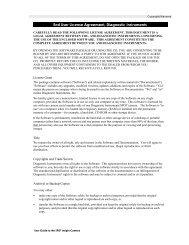optical interference filters - SPOT Imaging Solutions
optical interference filters - SPOT Imaging Solutions
optical interference filters - SPOT Imaging Solutions
You also want an ePaper? Increase the reach of your titles
YUMPU automatically turns print PDFs into web optimized ePapers that Google loves.
Types of Anti-Reflective<br />
Treatments and When to Use Them<br />
Application Note<br />
While no single solution fits all needs, by appropriately selecting the right anti-reflective technique, nearly any optic can be antireflected<br />
to meet the needs of the user.<br />
– by Dr. Michael Fink, Project Scientist, Omega Optical<br />
From the benign annoyance of a reflection off your car’s instrument<br />
panel window to the image-destroying reflections off of multiple<br />
<strong>optical</strong> components in a microscope, unwanted reflections plague<br />
our lives. Minimizing reflections has become a multimillion dollar<br />
industry. Scientific instruments with several <strong>optical</strong> components,<br />
such as modern confocal microscopes and, more commonly, television<br />
cameras, would be far less useful without the benefit of<br />
anti-reflective coatings.<br />
Discovery<br />
More than 70 years have passed since the first anti-reflective coating<br />
was discovered by a Ukrainian scientist working for Zeiss in Germany.<br />
While the anti-reflective coating was first implemented on binoculars<br />
in the German military, the new finding quickly expanded to a<br />
wide variety of <strong>optical</strong> elements in the research laboratory.<br />
On Reflections<br />
First, it is probably worthwhile to consider why reflections occur.<br />
Reflection of light occurs at any surface between two mediums with<br />
different indices of refraction. The closer the two indices of refraction,<br />
the less light will be reflected. If an optic could be made out of<br />
a material with the same index of refraction as air, then there would<br />
be no reflections at all. Of course, lenses would not focus light if<br />
they didn’t have an index of refraction that differed from that of air<br />
(or whatever medium they’re immersed in).<br />
Figure 1 Percent reflectance of s and p-polarized light off silicon and fused<br />
silica surfaces depending on angle of incidence.<br />
( n<br />
Si = 4.01, n<br />
fused silica = 1.46).<br />
In general, the reflection of light off of a surface will increase as<br />
the angle of incidence varies further from normal. However, this is<br />
not true for light that is p-polarized. Reflection of p-polarized light<br />
will decrease as the angle of incidence increases from normal (0°)<br />
to some angle at which there is no reflection. This angle at which<br />
there is no reflection of p-polarized light is called Brewster’s angle<br />
and varies depending on the indices of refraction of the two media.<br />
For 1,064 nm light at an interface of air and fused silica, Brewster’s<br />
angle is approximately 55.4°. Brewster’s angle is different depending<br />
on the two media that comprise the interface. Figure 1 compares<br />
the reflection of s- and p-polarized light for air-fused silica<br />
and air-silicon surfaces. At angles of incidence greater than Brewster’s<br />
angle, the reflection of both s- and p-polarized light increases<br />
dramatically as the angle of incidence increases.<br />
Uses and Misuses<br />
of Anti-Reflective Treatments<br />
Often, anti-reflective coatings are used to increase transmission of<br />
an optic. This is often a valid use of an anti-reflective coating, but it<br />
should be noted that this coating does not, by definition, increase<br />
transmission. Rather, it only reduces reflections off the incident side<br />
of the surface. In some cases, absorptive anti-reflective treatments<br />
can actually reduce transmission. In the case of <strong>interference</strong> <strong>filters</strong>,<br />
an anti-reflective treatment is often superfluous. An <strong>interference</strong> filter<br />
is intentionally reflective at wavelengths that are not being passed,<br />
so the total reflection off the optic will not be effectively reduced by<br />
an anti-reflective treatment. Furthermore, exposed <strong>interference</strong> <strong>filters</strong><br />
are often already anti-reflected at the passed wavelengths, so an<br />
extra anti-reflective coating usually has little effect.<br />
In many cases, the enhanced transmission of some anti-reflective<br />
coatings is very necessary. In fact, the advent of anti-reflective optics<br />
has made new <strong>optical</strong> instruments containing many-element apparatuses<br />
feasible. For example, a modern confocal microscope might<br />
have 15 or 20 <strong>optical</strong> elements in the light path. Borosilicate glass<br />
that has not been treated to eliminate reflections typically has a reflectance<br />
of about 4% in visible wavelengths per surface. A piece<br />
of borosilicate glass with a simple multilayer anti-reflective coating<br />
might average 0.7% reflectance per surface. When a single interface<br />
is concerned, the difference between 96% transmission and<br />
99.3% transmission seems miniscule. However, in a multi element<br />
light path, this difference becomes very significant. If an incident<br />
light path crosses 30 air-glass surfaces, the final transmitted light at<br />
the end of the path would only be approximately 29% for non-antireflection<br />
treated optics. An identical path with anti-reflection treated<br />
parts would be 81%.<br />
For current product listings, specifications, and pricing:<br />
www.omega<strong>filters</strong>.com • sales@omega<strong>filters</strong>.com<br />
1.866.488.1064 (toll free within USA only) • +1.802.254.2690 (outside USA)<br />
29

















